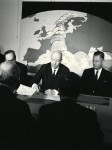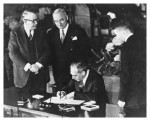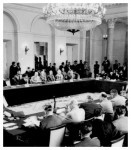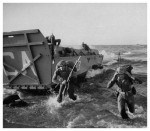
The Cold War world featured several alliances, such as the North Atlantic Treaty Organisation (NATO) and the Warsaw Pact. These alliances defined and intensified the divisions between democratic and socialist nations. They took shape in the years following World War II, as European nations aligned with others to protect themselves from future aggression. Some believed this aggression might come from resurgent Nazism, either as a secret counter-attack or as guerrilla resistance to Allied occupation. Others believed the menace would come from the Soviet Union and communist agents and revolutionaries. In March 1947, Britain and France signed the Treaty of Dunkirk, a bipartisan military alliance. In March 1948 they extended this alliance by signing the Treaty of Brussels, a new agreement that included Belgium, Luxembourg and the Netherlands. While the Treaty of Brussels did not mention the Soviet Union specifically, it was predicated on resisting communism and communist expansion. The preamble to the Brussels treaty expressed clear political aims: to “fortify and preserve the principles of democracy, personal freedom and political liberty, the constitutional traditions and the rule of law” that were the “common heritage” of the five signatory nations.
Just weeks after the signing of the Treaty of Brussels, Soviet forces initiated their blockade of Berlin. Interpreting this as an act of aggression, the signatories to the Brussels treaty formed their own military agency: the Western Union Defence Organisation. Despite this move, these nations still harboured concerns about their ability to respond to Soviet military aggression. Like most other European nations, the Brussels signatories had demobilised and reduced their military forces at the end of World War II. Even their combined forces were incapable of serving as a deterrent to Soviet aggression or responding adequately in the event of war with the USSR. Western European nations began lobbying the United States, urging the formation of a trans-Atlantic military alliance. Following lengthy negotiations, the North Atlantic Treaty was signed in Washington in April 1949.

The members of the North Atlantic Treaty Organisation (NATO) included the US, all five Brussels treaty nations, Canada, Denmark, Iceland, Italy, Norway and Portugal. Several countries were invited to join NATO but refused, including Finland, Ireland, Sweden and the ever-neutral Switzerland. Three more countries (Greece, Turkey and West Germany) were later admitted to NATO during the 1950s. France was a foundation member but its military commitment to NATO was gradually reduced between 1959 and 1966, as Charles de Gaulle and his government chose to formulate their own defence strategies. Under the terms of the North Atlantic Treaty, an “armed attack” against any of the signatory nations was to be “considered an attack against them all”, requiring members to take “such action as [they deem] necessary, including the use of armed force, to restore and maintain the security of the North Atlantic area.”

In its first year, NATO was little more than a loose affiliation of nations exchanging military expertise, advice and hardware. The onset of the Korean War in 1950 hardened the alliance, prompting NATO to expand and develop new command structures. In 1952 the office of NATO secretary-general was created and NATO’s headquarters were moved from small offices in London to a dedicated complex in Paris. Exercise Mainbrace, the first NATO ‘war games’, were conducted in northern European waters by the navies of nine member-states. NATO commanders also drew up war plans and strategies to deal with various Soviet attack or invasion scenarios. In 1954, a year after the death of Joseph Stalin, NATO was tested by a request for membership from the Soviet Union. The proposal was rejected by NATO member-states, who said ‘the unrealistic nature of the proposal does not warrant discussion’.

The final straw came on May 9th 1955 when West Germany was granted member status of NATO. Five days later Moscow convened a conference of communist delegates in the Polish capital Warsaw. They drafted and signed the Treaty of Friendship, Cooperation and Mutual Assistance, more commonly known as the Warsaw Pact. The pact’s eight member-nations were the USSR, Poland, East Germany, Albania (until 1968), Bulgaria, Czechoslovakia, Hungary and Romania. In a similar vein to NATO, the Warsaw Pact had civil, political and military committees and its own headquarters, located in Warsaw. Its planning, decision-making and military command, however, were dominated by the Soviet Union. Warsaw Pact bodies were led by Soviet politicians, diplomats or bureaucrats; the supreme commander of Warsaw Pact forces was also the Soviet deputy defence minister. This stood in contrast with American involvement in NATO: the United States was undoubtedly the major military partner but did not command or control the alliance.

The formation of the Warsaw Pact sparked a revision of NATO and an escalation of its activities. NATO members moved to grant membership to West Germany, believing its population would be crucial in the event of a war with the Soviet bloc. NATO also increased the size and frequency of its exercises. In September 1957, more than 300 NATO ships and a quarter-million men took part in joint exercises in the North Atlantic Sea and the Mediterranean. The first of these, Operation Strikeback, took the form of a mock battle against an enemy submarine fleet. NATO forces also participated in Operation Deep Water, responding to a simulated Soviet invasion of the Dardanelles (Turkey). In central Europe, Operation Counter Punch tested NATO’s air defence capabilities.

One of the more controversial aspects of NATO was its nuclear-sharing arrangements. Under this scheme, American nuclear weapons, bombers and missile systems were provided to non-nuclear NATO states. Access codes for these weapons remained with the US military – but in the event of a war with the Soviet bloc, these nuclear codes would be provided to host states. Nuclear sharing began in 1954 with the deployment of US nuclear weapons in Britain. Other European countries provided with nuclear weapons included West Germany, Italy, Greece, Belgium and Turkey. In contrast, the Warsaw Pact resisted any form of nuclear-sharing. Soviet nuclear weapons were certainly deployed in satellite states but their use was controlled entirely by Moscow.
“NATO began as a military alliance, but it was never just a military alliance of the traditional sort. As US secretary Dean Acheson said, ‘the North Atlantic Treaty is far more than a defensive arrangement. It is an affirmation of the moral and spiritual values we hold in common.’ Stanley Sloan affirms this: ‘What made NATO different from previous military alliances was that the Treaty’s preamble clearly articulated allied support for democracy, individual liberty and the rule of law.'”
Michael J. Williams, historian
NATO and the Warsaw Pact existed alongside several other Cold War treaties and alliances. In September 1951 the US, Australia and New Zealand signed the ANZUS treaty, a tripartite military alliance. The US-NZ arm of this alliance broke down in 1985, following disputes over American nuclear ships docking in New Zealand ports. Washington signed a Mutual Defence Treaty with the Republic of China (Taiwan) in 1954, providing the latter with American support in the event of an attack or invasion by communist China. A September 1954 pact, signed in Manila, formed the South-East Asia Treaty Organisation (SEATO), an anti-communist alliance – in effect, an Asian-Pacific version of NATO. There was a myriad of other smaller treaties and agreements signed by individual nations, which reflected both their domestic and regional interests as well as Cold War factors.

1. The Cold War world was shaped and divided by political and military alliances. The best known of these alliances were NATO and the Warsaw Pact, formed in Europe after World War II.
2. The North Atlantic Treaty Organisation or NATO was formed in 1949, an expansion of the Treaty of Brussels. It was formed to counter the threat of Soviet expansion or aggression in Europe.
3. After unsuccessfully seeking to join NATO, the Soviet Union responded by forming its own military alliance. The eight-nation Warsaw Pact was signed in 1955.
4. The Warsaw Pact led to an increase in NATO planning and operations. NATO held a number of multilateral exercises and war games. The US also engaged in nuclear-sharing with member-states.
5. There were bilateral and multilateral Cold War treaties signed in other regions too, such as the ANZUS treaty between the US, Australia and New Zealand, and the formation of SEATO in the Asia-Pacific.

The Treaty of Dunkirk (1947)
The Treaty of Brussels (1948)
The North Atlantic Treaty (1949)
The ANZUS Treaty (1951)
The Manila Pact or SEATO (1954)
The Warsaw Pact (1955)
Content on this page is © Alpha History 2018. This content may not be republished or distributed without permission. For more information please refer to our Terms of Use.
This page was written by Jennifer Llewellyn, Jim Southey and Steve Thompson. To reference this page, use the following citation:
J. Llewellyn et al, “Cold War alliances”, Alpha History, accessed [today’s date], https://alphahistory.com/coldwar/cold-war-alliances/.
